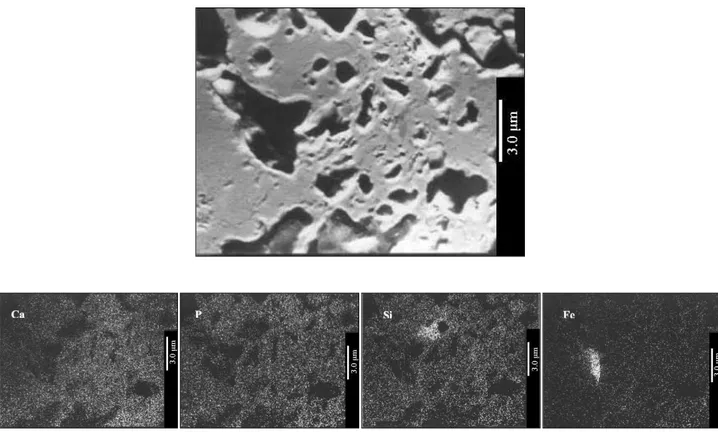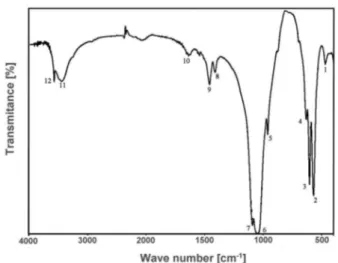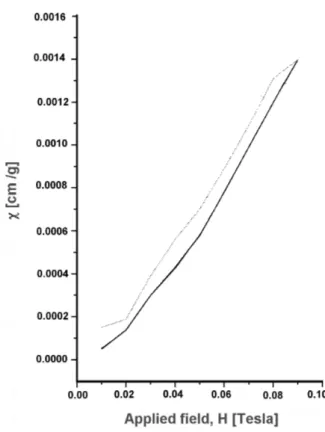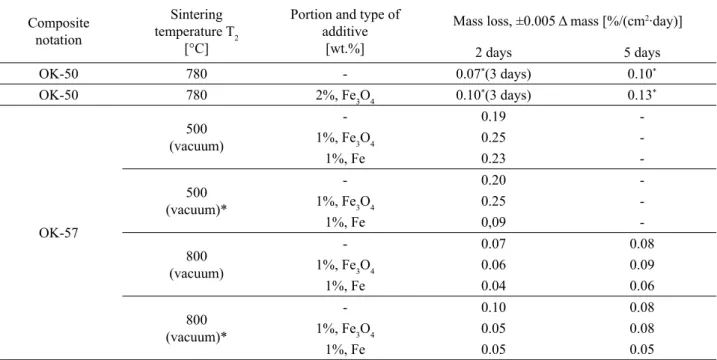Processing and characterization of glass reinforced biogenic
hydroxyapatite composites with ferromagnetic additives
Nataliya Pinchuk
1*, Oleksiy Kuda
1, Liana Ivanchenko
1, Vasyl Lazorenko
1,
Marcin Leonowicz
2, M. Szutkowska
31Frantsevich Institute for Problems of Materials Science of NAS of Ukraine, Krzhizhanovsky str. 3, Kiyv
03142 Ukraine
2Warsaw University of Technology, Pl. Politechniki 1, 00-661 Warsaw, Poland
3Institute of Advanced Manufacturing Technology, Wrocławska 37A, 30-011 Kraków, Poland
Received 13 August 2007; received in revised form 5 May 2008; accepted 21 May 2008
Abstract
Biogenic hydroxyapatite-glass composites, with addition of up to 2 wt.% of Fe or Fe3O4,were fabricated from biogenic hydroxyapatite powder and four types of reinforcing glasses by sintering under different con-ditions. It has been established that the relative density, mechanical and magnetic properties of the prepared composites depend on the composition and sintering conditions. The composites with 1 wt.% Fe or Fe3O4 sintered at 500°С in vacuum have a magnetic susceptibility of 2–3·10-3 cm3/g. This parameter decreases to 0.858·10-3 cm3/g for the specimens with 1 wt.% additives sintered at 800°С in vacuum and to 0.27–1.3·10-3 cm3/g for the specimens with 2 wt.% additives sintered at 500°С under the usual atmospheric conditions. The magnetic susceptibility for the specimens with 2 wt.% additives sintered at 780°С under the same atmo-spheric conditions decreases to 0.24–1.25·10-6 cm3/g. These ferromagnetic additives infl uence the degrada-tion rate in vitro within the fi rst 40 min of the composite soaking. Short-term treatment of specimens by the magnetic fi eld leads to an increase in the initial degradation rate, but insignifi cantly infl uences it within more prolonged soaking.
Keywords: bioceramics, hydroxyapatite-glass composites, magnetic susceptibility, porosity
* Corresponding author: tel: +380 44 424 1524
fax: +380 44 424 2131, e-mail: pinchuk@ipms.kiev.ua
I. Introduction
Hydroxyapatite (HAp) is used predominantly to re-place bone tissue in many biomedical applications in the form of granules or separate blocks. The works, carried out by Santos et al. [1], have shown that HAp could be reinforced by adding a P2O5-CaO glassy phase during its sintering. Other authors have also shown that phosphate glasses added to HAp promote atomic diffusion and development of strong bonds with crys-tal particles, and densifi cation occurs via liquid for-mation [2–4]. It has been shown [5]that an average hardness of 383 HV, density of 2.72 g/cm3, and
com-pressive strength of 83 MPa are achieved by sinter-ing at 1200°C with addition of 10 wt.% phosphate bio-glass into HAp.
The authors have shown that granules of biogenic hydroxyapatite (BHAp) can be reinforced by the Na-B-Si glasses addition (15–70 wt.%) [6]. Mechanical strength of such glass reinforced BHAp is high enough, and Si-O complexes in their composition activate the interaction of an implant with bone tissue [7].
biomaterial of interest, and can be remo ved from the matrix using a magnetic fi eld, but they do not agglom-erate after the cutting the fi eld off [8].
In this study, BHAp-glass composites were sintered together with magnetite or iron nanopowders, which are commonly used in medical applications due to their low reactivity. The structure and properties of such compos-ite material are presented and discussed.
II. Experimental
Different BHAp-glass composites, with addition of up to 2 wt.% of Fe or Fe3O4, were prepared from BHAp pow-der and four types of reinforcing glasses by sintering unpow-der different conditions. The BHAp powder was produced by treatment of mammal’s native bones corresponding to the medical requirements ASTM F1185-88. The compositions of four different reinforcing glasses, used for preparation of the BHAp-glass composites, are presented in Table 1.
The BHAp-glass samples were prepared by classi-cal ceramic technology using two-stage sintering pro-cedure (the fi rst sintering temperature was 1100°C, whereas the second one was selected depending on the type of BHAp-glass composites) [6]. Thus, the OK-50 and OK-50(M3) composites were produced using the second sintering temperature of T2=780°C. The OK-57 specimens were sintered in vacuum at 500 or 800°C to reduce ferromagnetic additive oxidation. The OK-85 specimens were, in the second stage, sintered at 500°C under the usual atmospheric conditions (Table 2).
The iron powders with an average particle size of 60 nm were obtained by Kushchevska [10]. The magne-tite (Fe3O4) powders, produced by Integran Techn., had an average particle size of 9 nm. Ferromagnetic additives (1 or 2 wt.%) were introduced into composite powders by mechanical mixing before second-stage sintering. The primarily sintered composites were ground into granules
≤ 160 μm, mixed with additives and pressed into regular cylindrical specimens for secondary sintering.
The specimen compositions were determined us-ing chemical, X-ray and infrared spectroscopy analy-ses (specimen/KBr weight ratio was 15/300). To study the composite microstructure, the scanning electron mi-croscope CAMEBAX was used. Magnetic susceptibility was measured by Faraday’s method relative to the strong paramagnetic material GdB4 with the known temperature dependence of magnetic susceptibility [11,12].
Taking into consideration the small cylindrical siz-es (15.0 mm diameter and 8.0 mm height) of the tsiz-ested specimens, the measurements of mechanical properties were limited to the compressive splitting strength and indentation fracture toughness. The compressive split-ting strength, Rcs, was determined by compression of a disc with fl atness 0.02 mm, according to:
Rcs=2 P/π D t (1)
where P is the splitting load, D is the diagonal of the disc and t is the disc thickness.
Table 1. Composition of reinforcing glasses used for preparation of the BHAp-glass composites
Composite notation
Composition [wt.%]
SiO2 Na2O K2O CaO MgO B2O3 Total
ОК-50 46 26 - - - 28 100
ОК-50(М3) 66 16 3 1 - 14 100
ОК-57 56 21 1.5 0.5 - 21 100
ОК-85 70.4 29.6 - - - - 100
Table 2. Composition, sintering condition and some parameters of the BHAp-glass composites
Composite notation
BHAp [wt.%]
Sintering temperature T2
[°C]
Portion and type of additive
[wt.%]
Porosity (±1.3) [%]
Relative density (±0.04) [g/cm3]
Magnetic susceptibility χ•106
[cm3/g]
OK-50 50 780 - 40 1.63 0.25–0.48
2%, Fe3O4 40 1.64 0.25–1.25
OK-50(М3) 50 780 - 45 1.49 0.20–0.41
2%, Fe3O4 41 1.60 0.24–1.18
ОК-57
57 500
(vacuum)
- 50 1.34
-1%, Fe3O4 50 1.34 3000.00
1%, Fe 53 1.34 2000.00
57 800 (vacuum)
- 54 1.36
-1%, Fe3O4 54 1.33
-1%, Fe 54 1.36 858.00
ОК-85 85 500
- 60 1.21
-2%, Fe3O4 powder - 270.00
The fracture (splitting) of the specimen occurs along the diagonal. Strength properties were studied using the Instron system with a rate of 0.2 mm/min. Indentation fracture toughness KIC was determined by means of di-rect crack measurements. The relationship between the fracture toughness and the size ratio crack/indent with the known Young’s modulus exhibited a universal be-haviour. The median/radial type of cracks with c/a≥ 2.5 can be described according to:
(KICφ/H a1/2) (H/Eφ)2/5 = 0.129 (c/a)-3/2 (2)
where KIC is the critical stress intensity factor, H is the Vickers hardness, E is the Young modulus, a is the half-diagonal of the indent, c is the sum of the later and the crack length and φ is theconstrain factor. The right side of this equation is equal to 0.035 (c/a)-1/2 for cracks of
Palmqvist type. Young’s modulus E, Poisson’s ratio and shear modulus G were evaluated using measurements of the propagation rate of longitudinal and crosswise ultrasonic waves. Microhardness was measured in micro-areas at a load of 25 G (HV.025).
To evaluate the bioactivity of the investigated com-posites, they were immersed at 36–37°C in medical iso-tonic physiological solution (0.9% NaCl) and human blood plasma with a solid/liquid ratio of 1 g/30 ml. A change in pH of physiological solution was measured over soaking time from 5 to 120 min. To evaluate the infl uence of the additional magnetization of some com-posites on their bioactivity, they were exposed for 30 sec to the magnetostatic fi eld (600 Oe).
III. Results and Discussion
In accordance with the chemical analysis of com-posites, the calcium and silicon contents corresponded to the calculated ones with an error of ±0.5 wt.%. The XRD pattern showed a crystalline structure, in which the major phase was Ca10(PO4)6(OH)2.
An example of SEM micrograph of the investigat-ed specimen surfaces and distribution of Ca, P, Si, and Fe is presented in Fig. 1. It indicates on uniform distri-bution of calcium, phosphorus and silicon, but not-uni-form distribution of iron ions, which are partly in the form of large agglomerates (up to ~20 μm).
A typical IR transmission spectrum of the investigat-ed composites is presentinvestigat-ed in Fig. 2. The spectral posi-tions of the basic absorption bands for the BHAp and some composites are given in Table 3. The basic IR ab-sorption bands are related to the vibrations of ( О4)
3-and (OH)- complexes. The absorption band 6 near 1050
cm-1 changes most of all. It is related to ( О 4)
3-
com-plexes and to intense absorption of Si-O comcom-plexes in the glass phase. The presence of iron oxides in the in-vestigated specimens is determined by the band 10 near 1629.3 cm-1. It was shown that the displacement
of the IR-absorption bands of the composites with Fe and Fe3O4 additives in relation to ones without them is in the limits for the other specimens. The presence of some other absorption bands, for example the bands 8 and 9 (Table 3), indicate on the presence of admixtures remained in the initial BHAp after the removal of the bone organic constituent.
Selected mechanical properties of the tested materi-als are presented in Table 4. It can be seen that micro-hardness is in the range of 150–542 HV. The addition of 2 wt.% Fe3O4 to the ОК 50(М3) resulted in increase of microhardness. Within the precipitates of the Fe3O4 phase observed in that sample the microhardness reach-es 542 HV. Comprreach-essive splitting strength of the OK-50 and OK-50(M3) specimens (measured along the sample diameter) is within a range of 3.6–5.0 MPa. The
OK-57 composites sintered in vacuum showed low com-pression splitting strength (<1 MPa). Modulus of rigid-ity and Poisson’s ratio are in ranges of 7.9–9.7 GPa and 0.252–0.307, respectively. The composite compressive strength is in the range 63–126 MPa and depends on a specimen porosity and treatment with the physiological solution (Table 4). The ferromagnetic additions lead to increase in compressive strength of the untreated sam-ples (before soaking), but its decrease for the samsam-ples soaked in the physiological solution.
For all the specimens, the indentation fracture tough-ness KIC, is within the range 0.6–1.0 MPa m1/2.
Mechan-ical properties of the sample OK-50 with 2 wt.% Fe3O4 are somewhat different from the other tested materials. This specimen exhibits the highest Young’s modulus and relative density (Table 2), but its compressive split-ting strength (Rcs=3.6 MPa) and Poisson’s ratio ( =0.25) are lower. This is apparently related to its higher poros-ity, which makes walls of the pores thinner and proner to the fracture.
To evaluate magnetic susceptibility of the composites with Fe and Fe3O4 additives, hysteresis loops were deter-mined (Fig. 3). The OK-57 composites with 1 wt.% Fe or Fe3O4 powders sintered at 500° in vacuum have a mag-netic susceptibility of 2–3·10-3 cm3/g (Table 2). This
pa-rameter decreases to 0.858·10-3 cm3/g for the OK-57
spec-imens with 1 wt.% additives sintered at 800° in vacuum
Figure 2. IR transmission spectrum of the ОК 57 (1 wt.% Fe) composite
Table 3. Spectral positions of basic IR absorption bands of BHAp composites
Band No.*
BHAp ОК-50 ОК -57
OK-50(M3) +2% Fe3O4
ОК-57 +1% Fe3O4
ОК-57
+1% Fe Fe3O4 Complex
Wave number of IR absorption band [cm-1](±0.5 cm-1)
1 473.2 473 469.1 472.3 472.3 - [PO4]
3-2 569.2 570 570.1 569.5 569.9 567.6 [PO4]3-, Fe–O
3 604.0 604 603.1 603.8 603.6 - [PO4]
3-4 632.4 633 ~630 632.6 632.4 - [OH]
-5 961.8 961 ~960 961.2 961.4 - [PO4]
3-6 1050 1047 1048.4 1045.9 1047 - [PO4]3-, Si-O
7 1090 1090 ~1090 1090.1 1090.4 - [PO4]
3-8 1411.8 - ~1411 1412.1 1411.5 - –О , –N
9 1456.9 1457.2 ~1460 1458.2 1459.0 - –О , –N
10 1634.3 1633.8 1631.9 1637.6 1629.9 1629.3 Fe–O
11 3421.8 3433 3422.0 3437.4 3431.7 3427.3 H2O
12 3571.7 3570 ~3570 3570.2 3570.5 - [OH]
-* See numbers in Fig. 2
Table 4. Mechanical properties of BHAp composites
Composite notation
Portion and type of additive
[wt.%]
Compressive splitting strength
(±0.5) [MPa]
Young mod-ulus E (±0.5)
[GPa]
Microhardness HV.025
Compressive strength (±1) [MPa]
Before
soaking After soaking
ОК-50 - 5.0 23 240–445 70 121
ОК-50 2%, Fe3O4 3.6 25 150–460 115 63
ОК-50(М3) - - - 220–508 112 126
and to 0.27–1.3·10-3 cm3/g for the OK-85 specimens with
2 wt.% additives sintered at 500° under the usual at-mospheric conditions. The magnetic susceptibility for the OK-50 and OK-50(M3) specimens sintered at 780° under the same atmospheric conditions is only 0.20– 1.25·10-6 cm3/g (Table 2). The OK-50 and OK-50(M3)
composites revealed rather low susceptibility, probably due to the small volume fraction of the magnetic powder and to the partial oxidation of Fe3O4 (Table 2). The mag-netite susceptibility values of the OK-50 and OK-50(M3) specimens with 2 wt.% Fe3O4 are correlated. A nonuni-form distribution of iron ions in the investigated speci-mens leads to a certain spread of their magnetic suscep-tibility values. In the composites without additives, there is also certain amount of iron (0.02–0.20 wt.%) originat-ed from BHAp, which conditions their magnetic suscep-tibility (Table 2).
The comparison of mass losses in the composites with or without additives in both blood plasma and physiological solution indicates the infl uence of the iron ion presence on the degradation rate (Figs. 4 and 5, Ta-ble 5). It follows from Fig. 4 that the presence of iron ions in the OK-57 specimens increases their degrada-tion rate in the initial stage (for 40 min) of soaking in the physiological solution. The comparison of the OK-50 and OK-OK-50 (M3) specimens with or without
addi-Figure 3. Hysteresis loop for specimen OK-85 with 2% Fe
Figure 4. Dependence of the physiological solution pH change on the soaking time for OK-57 (a) and OK-57 with 1 wt.% Fe3O4 (b) composites without (1) and with (2) magnetic processing
a)
a)
b)
b)
tives indicates that degradation after 2–3 day soaking of the OK-50 composite with additives is different from that of the composite without Fe3O4 (Fig. 5).
It was established that the degradation rate of the OK-57 composites without additives processed by magnetic fi eld before their immersion in the physiolog-ical solution increased within the fi rst 40 min of soak-ing (Fig. 4a). Similar changes in the degradation rate were observed for the OK-57 specimens with 1 wt.% Fe3O4 (Fig. 4b). Analogous results were also obtained for the OK-50 specimens with 2 wt.% Fe3O4. The com-posite degradation in the physiological solution during more prolonged soaking weakly depends on treatment by magnetic fi eld (Table 5). The above features may be related to the effect of the local magnetic fi eld of com-posite ferromagnetic additives on their bioactivity in vi-tro. Short-term treatment by external magnetic fi eld of composites containing ferromagnetic ions strengthens their internal magnetic fi eld.
Addition of ferromagnetic ions to an implant based on the BHAp-glass biomaterials can increase the bone regeneration rate in vivo. The short-term processing of patient’s operated section with a weak magnetic fi eld can strengthen this effect both at the initial stage after implantation and over prolonged time.
IV. Conclusions
Biogenic hydroxyapatite-glass composites, with ad-dition of up to 2 wt.% of Fe or Fe3O4, were fabricat-ed from biogenic hydroxyapatite powder and different reinforcing glasses by sintering under different condi-tions. Sintering of BHAp-glass composites with ferro-magnetic additives at ≤ 500°C under the usual atmo-spheric conditions preserves high enough values of the
magnetic susceptibility up to 1.3·10-3 cm3/g. Sintering
them in vacuum makes it possible to increase magnet-ic susceptibility, but their mechanmagnet-ical strength is con-siderably decreased. The presence of ferromagnetic ad-ditives leads to an increase in the degradation rate in vitro of composites with both high and low magnetic susceptibility within the fi rst 40 min of soaking. Short-term processing of the composites (with addition of Fe or Fe3O4) with a magnetic fi eld leads to increase in their initial degradation rate.
References
1. A. Afonso, J.D. Santos, M. Vasconcelos, R. Branco, J. Cavalheiro, “Granules of osteoapatite and glass-re-inforced hydroxyapatite implanted in rabbit tibiae”,
J. Mater. Sci.–Mater. Med., 7 [8] (1996) 507–510. 2. F.N. Oktar, G. Goller, “Sintering effects on
mechan-ical properties of glass-reinforced hydroxyapatite composites”, Ceram. Int.,28 [6] (2002) 617–621. 3. G. Georgiou, J.C. Knowles, “Glass reinforced
hy-droxyapatite for hard tissue surgery Part 1: me-chanical properties”, Biomaterials, 22 [20] (2001) 2811–2815.
4. M. Safi na, T.Safronova, E. Lukin, “Ceramics based on calcium phosphate with resorbable phase and lower temperature of sintering”, Glass Ceram., 64
[7–8] (2007) 238–243.
5. G. Goller, H. Demirkiran, F.N. Oktar, E. Demirke-sen, “Processing and characterization of bioglass re-inforced hydroxyapatite composites”, Ceram. Int.,
29 (2003) 721–724.
6. N.D. Pinchuk, L.A. Ivanchenko, “Making calcium phosphate biomaterials”, Powder Metall. Metal Ce-ram., 42 [7–8] (2003) 357–371.
Table 5. Some results of experiments in vitro
Composite notation
Sintering temperature T2
[°C]
Portion and type of additive
[wt.%]
Mass loss, ±0.005 Δ mass [%/(cm2·day)]
2 days 5 days
OK-50 780 - 0.07*(3 days) 0.10*
OK-50 780 2%, Fe3O4 0.10*(3 days) 0.13*
OK-57
500 (vacuum)
- 0.19
-1%, Fe3O4 0.25
-1%, Fe 0.23
-500 (vacuum)*
- 0.20
-1%, Fe3O4 0.25
-1%, Fe 0,09
-800 (vacuum)
- 0.07 0.08
1%, Fe3O4 0.06 0.09
1%, Fe 0.04 0.06
800 (vacuum)*
- 0.10 0.08
1%, Fe3O4 0.05 0.08
1%, Fe 0.05 0.05
7. L.A. Ivanchenko, V.S. Sulima, N.D. Pinchuk, “The researches of properties of biomaterials based bio-logical hydroxyapatite in synthetic and natural phys-iological mediums”, pp. 77–82 in Nanostructured Materials and Coatings for Biomedical and Sensor Applications eds. by Y.G. Gogotsi and I.V. Uvaro-va, NATO Science Series, Kluwer Academic Pub-lishers. – II. Mathematics, Physics and Chemistry – Vol. 102, Dordrecht, Boston, London, 2003.
8. C. Martin, D. Mitchell, “Nanomaterials in Analyti-cal Chemistry”, Analytical Chemistry News & Fea-tures, Am. Chem. Soc., 1998, 322A–327A.
9. P. Tartay, M.P. Morales, T. Gonzales-Carreno, S. Veintemillas-Verdaguer, C.J. Serna, “Advances in madnetic nanoparticles for biotechnology
applica-tions”, J. Magn. Magn. Mater., 290-291 (2005) 28– 34.
10. N. Kushchevskaya “Phase composition and struc-ture of highly dispersed powders of iron and Its composites with platinum, silver, gold, copper and zinc”, Powder Metall. Metal Ceram., 42 [1–2] (2003) 24-30.
11. G. Lashkarev, D. Migley, A. Shevchenko, K. Tovstyuk, “Magnetic susceptibility and electrical properties of p-Pb1-xSnxTe”, Phys. Stat. Sol.(b), 63
(1974) 663–665.
![Table 2. Composition, sintering condition and some parameters of the BHAp-glass composites Composite notation BHAp [wt.%] Sintering temperature T 2 [°C]](https://thumb-eu.123doks.com/thumbv2/123dok_br/18161591.328855/2.892.85.808.848.1158/composition-sintering-condition-parameters-composites-composite-sintering-temperature.webp)



